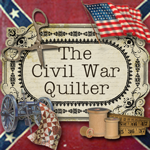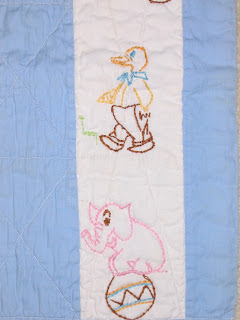Quilts that don't come with a date stitched into them or somehow inked on them have other ways of giving us clues as to their approximate age. Style is just one clue. Here is a general style guideline handed out at the first meeting of the Northern Virginia Quilt & Fabric Dating Club in June 1995. I have barely tweaked it. Any suggestions or additions?
As you can see, it doesn't go much beyond 1950. New categories have been established by quilt appraisers for quilts after 1950, I am sure, so it's probably time for me to update this list. But since most quilts in my collection pre-date 1960, I haven't yet taken the time to update my own list.
General Quilt Style Timeline
(includes whitework, trapunto-stuffed and corded,
Blue Resist)
Wool or worsted..........1750-1840
Cut-out chintz or Broderie Perse..........1775-1865
Pieced Chintz..........1775 - 1863
Square on point.........1800 - ??
Red and Green on white.........1830-1900
Blue (prints) and white..........1830—1930
Fancy silks..........1830-1910
Four Block (applieque not Broderie Perse)..........1840-1900
Album (all same block pattern)..........1840 - present
Album (appliqué Sampler)..........1840-1900
Two color quilts (red & white, blue & white, etc) 1840-1925
Hawaiian quilts..........1840 - present
Charm quilts..........1870-1950
Log Cabin at its peak..........1870-1890
Foundation (string and crazy)..........1875 – present
Utility and comforters..........1875 – 1950
Amish classics (wool)..........1880-1940
Outline embroidery (for fund raising to 1950).....1880 – present
Turn of 20th century dark colors..........1890-1925
Marie Webster’s appliqués appear in pastel colors in LHJ Jan 1911
Pastel – white background – Art Deco..........1915 – present
Fabric Dating
For me, the strongest clue is usually the fabric itself, but that took years of studying lots of old quilts and the clues break down within this category, too: scale of print, color scheme within individual prints, printing techniques, print styles, weave.
Solid colors can be a problem, though. Then you have to rely on any number of other clues, like pattern, style, the combination of the solid colors used in the quilt, dyes, etc.
Eileen Jahnke Trestain books, "Dating Fabrics, A Color guide 1800-1960" and "Dating Fabrics, A Color guide 1950-2000" are the two handiest guide books I have come across to help see the differences in color and design, era by era, at a glance.
Cheater Cloth or Faux Patchwork
Here are a couple of items from my doll quilt collection and yardage collection.
 |
| A circa 1890 doll quilt 11x17 |
Quilt segment (above showing) use of "cheater cloth" or "pre-printed patchwork" as most quilt historians prefer to call it now. Notice the different color-way on the back. I think the whole thing was "pre-created quilt" using "pre-printed patchwork" fabric.
Fairly recently produced printed patchwork honoring quilters.
Another delightful doll quilt (1930s) using printed patchwork fabric.
A darling quilted doll coat using printed patchwork cloth. Probably 1970s.
Unused printed patchwork yardage - 1960-70s?
Above a young child wears. pre-printed patchwork. My guess is 1970-1989. What do you think?
A dress of printed patchwork seen in Indiana. Probably 1950s.
Unused printed patchwork yardage - ca 1900-1925? Or is it a recent reprint mimicking that era?
Doll quilt - 13 x 23. The woman to whom this once belonged was born in 1917.
The daughter was selling her mother's belongings after he mother and passed and
did not know who made this little quilt.
Check out another preprinted "cheater-cloth" child's quilt in my collection here. It is a Raphael-Tuck & Sons preprinted fabric.







































































